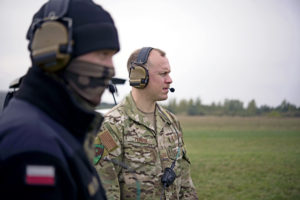
33rd AIR BASE, Poland — Each year, Airmen hailing from Ramstein Air Base come prepared to participate in a two-week exercise in tandem with the Polish air force near Powidz, Poland.
Known as 2021 Aviation Detachment Rotation, the exercise serves two important functions which contribute to continued stability in Europe.
First, ADR presents a unique opportunity to enhance interoperability between the U.S. and its NATO allies.
U.S. Air Force 1st Lt. Duncan Richards, 37th Airlift Squadron ADR tactician, explains what enhancing interoperability means specifically.
“To increase our interoperability with the Polish air force and other NATO partners means to form and build upon existing relationships while we’re here, ultimately allowing us to bring more air power to the skies.” Richards said.
With the public display of increased air power, each iteration of ADR contributes to sustained theatre deterrence against real or potential threats.
“There absolutely is an element of deterrence with Aviation Detachment Rotation,” Richards said. “We’re showing the world we’re able to work with our NATO allies at a very competent level and when we combine forces like we do during ADR, it shows how powerful we are together.”
In addition to increased interoperability and deterrence, the other primary function of ADR allows the U.S. Air Force to complete qualification training otherwise not possible at RAB.
Noteworthy areas of qualification training conducted at the 33rd AB are the grass take-off and landings.
“As a C-130J pilot, we take every opportunity we can get to train on unprepared surfaces which mirror those we might find in a contingency environment,” said Maj. Andrew Huddleston, 621st Mobility Support Operations Squadron air mobility liaison officer. “In this case, we have grass landing zones, which are very rare worldwide. So, the training opportunity we have here to practice assault landings on an unprepared surface is truly priceless for the crews of the 37th AS.”
Throughout the two weeks in Poland, RAB Airmen additionally train on simulated container delivery system drops, personnel and heavy equipment drops. Members from the 37th AS, 86th Logistics Readiness Squadron and 435th Contingency Readiness Squadron train on heavy equipment platforms and low-cost low-altitude procedures to practice getting in and out of a tactical environment quickly.
With training being a cornerstone of ADR, Richards underlined how valuable the training environment in Poland is for all participants.
“I believe continued funding for these kinds of forward training deployments is extremely important,” Richards said. “The connections we form out here, you can’t make that connection over the phone or over an email. We need to iron out all the plans here in person so if we did have to go into some kind of contingency we know the air space, we know what to expect, so we’ll know how to react.”
On an individual basis, Richards spoke highly of his experience so far during this iteration of ADR.
“This exercise is helping me realize how easy it is to interoperate with our allies,” Richards said. “The Polish are awesome and they share a lot of the same equipment we use, so that’s been great for me personally. On a broader level, I’d say ADR is showing me we have the capability to deploy anytime, anywhere and we can do that very effectively.”


